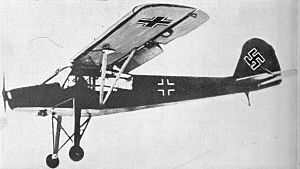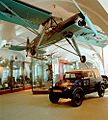Fieseler Fi 156 Storch facts for kids
Quick facts for kids Fieseler Fi 156 Storch |
|
|---|---|
 |
|
| Fieseler Fi 156 in flight. | |
| Role | Light support aircraft |
| National origin | Nazi Germany. |
| Manufacturer | Fieseler |
| First flight | 1936 |
| Introduction | 1937 |
| Status | Out of service |
| Primary user | Luftwaffe |
| Number built | 2900 examples |
The Fieseler Fi 156 Storch was a special light airplane built in Nazi Germany. Its name, "Storch," means "Stork" in German, which fits because it looked a bit like a stork with its long landing gear. This plane was designed to take off and land in very short spaces. It was mostly used during World War II for important jobs like carrying messages, moving people, and looking at enemy positions. After the war, it was even built in France under a different name, the Morane Saulnier MS-500 Criquet.
Contents
What Made the Storch Special?
The Fieseler Fi 156 Storch was famous for its amazing ability to take off and land in very small areas. This is called STOL (Short Take-off and Landing).
- It could take off in less than 60 meters (about 200 feet).
- It could land in even less space, sometimes as little as 20 meters (about 65 feet).
How Did It Fly So Slowly?
The Storch could fly very slowly without falling out of the sky. This was thanks to its special wing design.
- It had very large wings compared to its size.
- The wings had special flaps that could be lowered to create more lift and drag. This allowed the plane to fly at speeds as low as 50 km/h (31 mph).
- Its long landing gear also helped absorb shocks when landing on rough ground.
The Storch in World War II
During World War II, the Storch was a very useful aircraft for the German military, the Luftwaffe.
- Liaison and Communication: It carried important messages and people between different military units.
- Reconnaissance: It was used to scout ahead and observe enemy movements from the sky. Its slow speed and good visibility made it perfect for this.
- Rescue Missions: One of its most famous uses was in a daring rescue. In 1943, a Storch landed on a mountain in Italy to rescue Benito Mussolini, the former leader of Italy, who was being held prisoner. This showed how well the plane could land and take off in difficult places.
- Medical Evacuation: Sometimes, it was used to quickly move injured soldiers from the battlefield to hospitals.
Who Else Used the Storch?
Even though it was a German plane, its usefulness meant that other countries also used captured Storches during the war.
- The Royal Air Force (RAF) of Britain and the United States Army Air Forces (USAAF) sometimes used captured Storches for their own purposes.
- Its unique abilities made it valuable to anyone who could get their hands on one.
After the War: The French Criquet
After World War II ended, the Fieseler company stopped making the Storch. However, its design was so good that other countries wanted to keep building it.
- French Production: The French company Morane-Saulnier started building the Storch under a license. They called it the Morane-Saulnier MS.500 Criquet (which means "Grasshopper").
- Continued Use: These French-built planes were used for many years, even into the 1960s. They served in various roles, including observation and air ambulance duties.
- Other Countries: Some Storches were also built in other countries like Czechoslovakia and Switzerland.
The Storch Today
Even though the Fieseler Fi 156 Storch is an old plane, it is still admired by aviation fans.
- Many original Storches and French-built Criquets are still flying today.
- You can see them at airshows or in aviation museums around the world.
- Some companies even build modern replicas (copies) of the Storch because its design is still so effective for STOL flying.
Images for kids
-
Spanish Air Force Fi 156 and Argus As 10 engine at the Museo del Aire in Madrid
See also
 In Spanish: Fieseler Fi 156 para niños
In Spanish: Fieseler Fi 156 para niños















